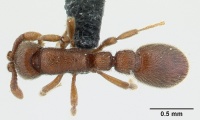Ooceraea biroi
| Ooceraea biroi | |
|---|---|

| |
| Scientific classification | |
| Kingdom: | Animalia |
| Phylum: | Arthropoda |
| Class: | Insecta |
| Order: | Hymenoptera |
| Family: | Formicidae |
| Subfamily: | Dorylinae |
| Genus: | Ooceraea |
| Species: | O. biroi |
| Binomial name | |
| Ooceraea biroi (Forel, 1907) | |
| Synonyms | |
| |
| Common Name | |
|---|---|
| Kubire-hari-ari | |
| Language: | Japanese |
| Clonal Raider Ant | |
| Language: | English |
A small, inconspicuous ant that has spread around the world in tropical and subtropical regions through human commerce. It is found in a range of habitats, nesting in soil or under stones. Colonies may include a few hundred workers and ergatoid queens.
| At a Glance | • Parthenogenetic • Highly invasive |
Identification
Dias et al (2018) - The species appears robust with opaque body having closely spaced piligerous punctures and dense pilosity. The species displays a great variation in colour and we also observed that the colour of specimens mostly corresponds to the colour of soil they inhabit. Mandibles subtriangular, dentate; antennae 9-segmented; scapes short and clavate reaching up to half of posterior head margin; eyes and ocelli absent; anterior clypeal margin entire and convex; vertex deflexed and flat.
Keys including this Species
- Key to Subfamily of Philippine Ants
- Key to Cerapachys of India
- Key to Micronesian Ants
- Key to species of Ooceraea
- Key to Ooceraea of China
Distribution
Latitudinal Distribution Pattern
Latitudinal Range: 32.7496° to 22.1575°.
| North Temperate |
North Subtropical |
Tropical | South Subtropical |
South Temperate |
- Source: AntMaps
Distribution based on Regional Taxon Lists
Afrotropical Region: Comoros.
Indo-Australian Region: Guam, Hawaii, Marshall Islands, Northern Mariana Islands, Philippines, Samoa, Singapore (type locality).
Malagasy Region: Madagascar, Mayotte, Seychelles.
Neotropical Region: Guadeloupe, Lesser Antilles, Puerto Rico, Trinidad and Tobago, Turks and Caicos Islands.
Oriental Region: India, Nepal, Sri Lanka, Taiwan, Vietnam.
Palaearctic Region: China, Japan.
Distribution based on AntMaps
Distribution based on AntWeb specimens
Check data from AntWeb
Countries Occupied
| Number of countries occupied by this species based on AntWiki Regional Taxon Lists. In general, fewer countries occupied indicates a narrower range, while more countries indicates a more widespread species. |

|
Estimated Abundance
| Relative abundance based on number of AntMaps records per species (this species within the purple bar). Fewer records (to the left) indicates a less abundant/encountered species while more records (to the right) indicates more abundant/encountered species. |

|
Biology
Wetterer et al. (2012) - Cerapachys biroi has small colonies, typically consisting of a few hundred workers. Workers are only 2-3 mm in size and are entirely subterranean. Cerapachys biroi feeds primarily on the brood of other ants (Tsuji and Yamauchi, 1995), but also may consume the soft-bodied larvae of other insects (Wocott, 1948). Cerapachys workers have heavily sclerotized cuticle that protects them against attack or injury when raiding the broods of other ants (Holldobler, 1982).
The reproductive cycle of Cerapachys biroi is similar to that of some army ants in that C. biroi colonies produce brood in distinct cohorts, synchronized with cycles of alternating statary and nomadic phases (Ravary and Jaisson, 2002, Ravary et al., 2006). Cerapachys biroi has received particular attention because, unlike most ants, all workers can produce diploid eggs through thelytokous parthenogenesis, although workers differ in their number of ovaries and their potential reproductive output (Tsuji and Yamauchi, 1995, Ravary and Jaisson, 2004, Lecoutey et el., 2011). This means that any colony fragment can theoretically found a new population. It is possible that this method of reproduction has facilitated the spread of C. biroi around the world.
Ravary and Jaisson (2002) examined life-history attributes of laboratory colonies of O. biroi . They documented a biphasic reproductive cycle (Figure 1) similar to that of a few specie of well-studied army ants, e.g., Eciton burchellii). There are two alternating phases of adult activity, a foraging phase and statary phase. Brood development is synchronous and larvae develop through three instars. The transition from the foraging to statary phase occurs when the brood are in the pupal stage and do not need to be fed. A new cohort of brood is produced by the now idled foragers, with virgin workers laying diploid eggs. The statary phase ends with the callow workers emerging as adults and the eggs hatch. The adult workers begin again to forage for food. This provides the food resources needed by the synchronously maturing larvae.
Life History Traits
- Queen type: absent (Tsuji and Yamauchi, 1995; Ravary & Jaisson, 2004; Mizuno et al., 2021) (clonal species without queen caste)
- Mean colony size: 150-600 (Tsuji and Yamauchi, 1995; Ravary & Jaisson, 2004; Mizuno et al., 2021)
Castes
Images from AntWeb
 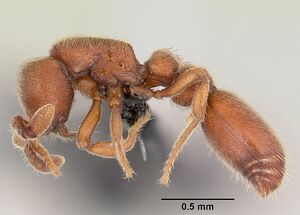  
| |
| Worker. Specimen code casent0059682. Photographer April Nobile, uploaded by California Academy of Sciences. | Owned by CAS, San Francisco, CA, USA. |
   
| |
| Syntype of Cerapachys ierensis. Worker. Specimen code casent0102253. Photographer April Nobile, uploaded by California Academy of Sciences. | Owned by NHMUK, London, UK. |
  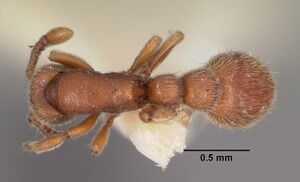 
| |
| Worker. Specimen code casent0102254. Photographer April Nobile, uploaded by California Academy of Sciences. | Owned by NHMUK, London, UK. |
   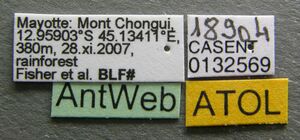
| |
| Worker. Specimen code casent0132569. Photographer Erin Prado, uploaded by California Academy of Sciences. | Owned by CAS, San Francisco, CA, USA. |
   
| |
| Queen (alate/dealate). Specimen code casent0133141. Photographer Erin Prado, uploaded by California Academy of Sciences. | Owned by CAS, San Francisco, CA, USA. |
   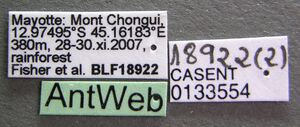
| |
| Worker. Specimen code casent0133554. Photographer Erin Prado, uploaded by California Academy of Sciences. | Owned by CAS, San Francisco, CA, USA. |
 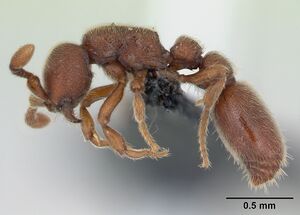  
| |
| Worker. Specimen code casent0135345. Photographer April Nobile, uploaded by California Academy of Sciences. | Owned by CAS, San Francisco, CA, USA. |
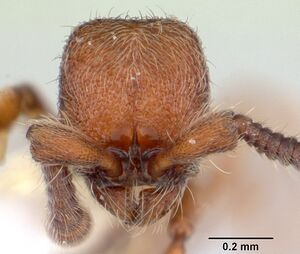  
| |
| Worker. Specimen code casent0178457. Photographer April Nobile, uploaded by California Academy of Sciences. | Owned by BNM, Koror, Palau. |
Nomenclature
The following information is derived from Barry Bolton's Online Catalogue of the Ants of the World.
- biroi. Cerapachys (Syscia) biroi Forel, 1907a: 7 (w.) SINGAPORE.
- Type-material: syntype workers (number not stated).
- Type-locality: Singapore: (L. Biró).
- Type-depositories: HNHM, MHNG.
- Imai, et al. 1984: 5 (k.).
- Combination in Ooceraea: Borowiec, M.L. 2016: 198.
- Status as species: Emery, 1911d: 10; Chapman & Capco, 1951: 20; Brown, 1975: 22, 73; Onoyama, 1980: 196; Ogata, 1983: 136; Terayama, et al. 1988: 38; Morisita, et al. 1989: 31; Brandão, 1991: 337; Bolton, 1995b: 142; Tang, J., Li, et al. 1995: 25; Wu, J. & Wang, 1995: 48; Imai, et al. 2003: 210; Lin & Wu, 2003: 60; Wetterer & Vargo, 2003: 417; Clouse, 2007b: 203; Framenau & Thomas, 2008: 58; Terayama, 2009: 121; Guénard & Dunn, 2012: 24; Wetterer, Kronauer & Borowiec, 2012: 1; Bharti & Akbar, 2013a: 82 (in key); Bharti & Wachkoo, 2013d: 1192 (in key); Bharti, Guénard, et al. 2016: 21; Chen, Shi & Zhou, 2016: 9 (in key); Yamada, Luong & Eguchi, 2018: 21 (in key); Rasheed, et al. 2019: 428; Zhou, Chen & Chen 2020: 142 (in key).
- Senior synonym of ierensis: Brown, 1975: 22, 73; Ogata, 1983: 136; Brandão, 1991: 337; Bolton, 1995b: 142.
- Senior synonym of seini: Brown, 1975: 22, 73; Ogata, 1983: 136; Brandão, 1991: 337; Bolton, 1995b: 142.
- Senior synonym of silvestrii: Brown, 1975: 22, 73; Onoyama, 1980: 196; Ogata, 1983: 136; Bolton, 1995b: 142.
- Senior synonym of sinensis: Brown, 1975: 22, 73; Ogata, 1983: 136; Bolton, 1995b: 142.
- Distribution [tramp species]:
- Malagasy: Comoros, Madagascar, Mauritius (Mascarene Is), Seychelles.
- Malesian: Christmas I., Hawaii, Indonesia (Bali), Malaysia (Peninsula), Micronesia, Philippines, Samoa, Singapore.
- Neotropical: Guadeloupe, Puerto Rico, Trinidad, Turks & Caicos Is, Virgin Is.
- Oriental: China, India, Japan, Nepal, Taiwan, Vietnam.
- ierensis. Cerapachys (Syscia) ierensis Weber, 1939a: 94 (w.) TRINIDAD.
- Type-material: syntype workers (number not stated, “a series”).
- Type-locality: Trinidad: St Augustine, 17.v.1935, and 20.v.1936 (N.A. Weber).
- Type-depositories: AMNH, MCZC.
- Status as species: Kempf, 1972a: 76.
- Junior synonym of biroi: Brown, 1975: 22, 73; Ogata, 1983: 136; Brandão, 1991: 337; Bolton, 1995b: 143.
- seini. Cerapachys (Syscia) seini Mann, 1931: 440, fig. 1 (w.) PUERTO RICO.
- Type-material: syntype workers (number not stated, “a series”).
- Type-locality: Puerto Rico: Insular Experiment Station, Rio Piedras (F. Sein).
- Type-depositories: MCZC, USNM.
- Status as species: Smith, M.R. 1937: 823; Kempf, 1972a: 76.
- Junior synonym of silvestrii: Wilson & Taylor, 1967: 33.
- Junior synonym of biroi: Brown, 1975: 22, 73; Ogata, 1983: 136; Brandão, 1991: 337; Bolton, 1995b: 144.
- silvestrii. Cerapachys (Syscia) silvestrii Wheeler, W.M. 1909c: 269 (w.) HAWAII.
- Type-material: 6 syntype workers.
- Type-locality: U.S.A.: Hawaii, Hilo (F. Silvestri).
- Type-depository: MCZC.
- [Note: according to Brown, 1975: 73, only 1 syntype is in MCZC; the remainder may be in DEUN.]
- Combination in Syscia: Wilson & Taylor, 1967: 33.
- Status as species: Emery, 1911d: 10; Wheeler, W.M. 1934h: 9; Wheeler, W.M. 1935g: 8; Wilson & Taylor, 1967: 33; Dlussky, 1994: 53 (error).
- Junior synonym of biroi: Brown, 1975: 22, 73; Onoyama, 1980: 196; Ogata, 1983: 136; Bolton, 1995b: 144.
- sinensis. Cerapachys (Syscia) sinensis Wheeler, W.M. 1928c: 3 (w.) CHINA (Shanghai).
- Type-material: holotype worker.
- Type-locality: China: Shanghai (F. Silvestri).
- Type-depository: MCZC.
- Status as species: Wheeler, W.M. 1930h: 57; Chapman & Capco, 1951: 20.
- Junior synonym of biroi: Brown, 1975: 22, 73; Ogata, 1983: 136; Bolton, 1995b: 144.
Description
Karyotype
- See additional details at the Ant Chromosome Database.
 Explore: Show all Karyotype data or Search these data. See also a list of all data tables or learn how data is managed.
Explore: Show all Karyotype data or Search these data. See also a list of all data tables or learn how data is managed.
- 2n = 28, karyotype = 25M+3A (India) (Imai et al., 1984) (as Cerapachys biroi).
References
- Bharti, H. & Akbar, S.A. 2013b. Taxonomic studies on the ant genus Cerapachys Smith (Hymenoptera, Formicidae) from India. ZooKeys 336: 79–103. doi: 10.3897/zookeys.336.5719.
- Bharti, H., Rilta, J.S., Dhadwal, T. 2021. Two new species of Ooceraea (Hymenoptera, Formicidae, Dorylinae) from India with ten-segmented antennae. ZooKeys 1010, 165–183 (doi:10.3897/zookeys.1010.58436).
- Borowiec, M.L. 2016. Generic revision of the ant subfamily Dorylinae (Hymenoptera, Formicidae). ZooKeys 608: 1-280 (doi:10.3897/zookeys.608.9427).
- Borowiec, M.L. 2019. Convergent evolution of the army ant syndrome and congruence in big-data phylogenetics. Systematic Biology 68, 642–656 (doi:10.1093/sysbio/syy088).
- Boulay, R., Cerda, X., Fertin, A., Ichinose, K., Lenior, A. 2009. Brood development into sexual females depends on the presence of a queen but not on temperature in an ant dispersing by colony fission, Aphaenogaster senilis. Ecological Entomology 34, 595–602 (doi:10.1111/j.1365-2311.2009.01108.x).
- Brassard, F., Leong, C.-M., Chan, H.-H., Guénard, B. 2021. High diversity in urban areas: How comprehensive sampling reveals high ant species richness within one of the most urbanized regions of the world. Diversity 13, 358 (doi:10.3390/d13080358).
- Brown, W. L., Jr. 1975. Contributions toward a reclassification of the Formicidae. V. Ponerinae, tribes Platythyreini, Cerapachyini, Cylindromyrmecini, Acanthostichini, and Aenictogitini. Search Agric. (Ithaca N. Y.) 5(1 1: 1-115 (page 22, Senior synonym of irensis, silvestrii (and it junior synonym seini) and sinensis)
- Bulter, I. 2020. Hybridization in ants. Ph.D. thesis, Rockefeller University.
- Dekoninck, W., Wauters, N., Delsinne, T. 2019. Capitulo 35. Hormigas invasoras en Colombia. Hormigas de Colombia.
- Du, C., Xu, Z., Chen, Z. 2024. Taxonomic account of the ant genus Syscia Roger, 1816 (Hymenoptera, Formicidae) from Asia, with descriptions of two new species from China. European Journal of Taxonomy 930, 157-181 (doi:10.5852/ejt.2024.930.2491).
- Forel, A. 1907d. Formicides du Musée National Hongrois. Ann. Hist.-Nat. Mus. Natl. Hung. 5: 1-42 (page 7, worker described)
- Gao, Q., Long, J., Liu, C., Liu, H., Ran, H., Lacy, K.D., Kronauer, D.J.C. 2024. Ooceraea hainingensis sp. nov.: A new Chinese Ooceraea (Hymenoptera, Formicidae, Dorylinae) species with a dealate queen, closely allied to the queenless clonal raider ant O. biroi. ZooKeys 1205, 101–113 (doi:10.3897/zookeys.1205.118358).
- Gospocic, J., Glastad, K.M., Sheng, L., Shields, E.J., Berger, S.L., Bonasio, R. 2021. Kr-h1 maintains distinct caste-specific neurotranscriptomes in response to socially regulated hormones. Cell 184, 5807–5823.e14 (doi:10.1016/j.cell.2021.10.006).
- Heterick, B.E. 2022. A guide to the ants of Western Australia. Part II: Distribution and biology. Records of the Western Australian Museum, supplement 86: 247-510 (doi:10.18195/issn.0313-122x.86.2022.247-510).
- Hita Garcia, F., Fischer, G., Liu, C., Audisio, T. L., Economo, E. P. 2017. Next-generation morphological character discovery and evaluation: an X-ray micro-CT enhanced revision of the ant genus Zasphinctus Wheeler (Hymenoptera, Formicidae, Dorylinae) in the Afrotropics. ZooKeys 693, 33–93 (doi:10.3897/zookeys.693.13012).
- Imai, H. T.; Baroni Urbani, C.; Kubota, M.; Sharma, G. P.; Narasimhanna, M. H.; Das, B. C.; 1984. Karyological survey of Indian ants. Jpn. J. Genet. 59: 1-32 (page 5, karyotype described)
- Ito, F., Makita, S., Nakao, H., Hosokawa, R., Kikuchi, T., Yamane, S. 2021. Thelytokous parthenogenesis by dealate queens in the myrmicine ant Monomorium hiten distributed in Nansei Islands, western Japan, with description of the male. Asian Myrmecology 14: e014001 (doi:10.20362@am.014001).
- Jaitrong, W., Yamane, S., Wiwatwitaya, D. 2021. A new species and a new record of the ant genus Ooceraea Roger, 1862 (Hymenoptera: Formicidae: Dorylinae) from Thailand. Far Eastern Entomologist 441, 1–10 (doi:10.25221/fee.441.1).
- Lau, M.K., Ellison, A.M., Nguyen, A., Penick, C., DeMarco, B., Gotelli, N.J., Sanders, N.J., Dunn, R.R., Helms Cahan, S. 2019. Draft Aphaenogaster genomes expand our view of ant genome size variation across climate gradients. PeerJ 7, e6447 (doi:10.7717/PEERJ.6447).
- Liu, C., Fischer, G., Hita Garcia, F., Yamane, S., Liu, Q., Peng, Y.Q., Economo, E.P., Guénard, B., Pierce, N.E. 2020. Ants of the Hengduan Mountains: a new altitudinal survey and updated checklist for Yunnan Province highlight an understudied insect biodiversity hotspot. ZooKeys 978, 1–171 (doi:10.3897/zookeys.978.55767).
- Meurgey, F. 2020. Challenging the Wallacean shortfall: A total assessment of insect diversity on Guadeloupe (French West Indies), a checklist and bibliography. Insecta Mundi 786: 1–183.
- Mizuno, R., Suttiprapan, P., Jaitrong, W., Yamada, A., Ito, F. 2021. Colony composition, phasic reproduction, and queen–worker dimorphism of an oriental non-army ant doryline Cerapachys sulcinodis species complex in northern Thailand. Insectes Sociaux (doi:10.1007/s00040-021-00841-5).
- Nagel, M., Qiu, B., Brandenborg, L.E., Larsen, R.S., Ning, D., Boomsma, J.J., Zhang, G. 2020. The gene expression network regulating queen brain remodeling after insemination and its parallel use in ants with reproductive workers. Science Advances 6, eaaz5772 (doi:10.1126/sciadv.aaz5772).
- Ogata, K. 1983b. The ant genus Cerapachys F. Smith of Japan, with description of a new species (Hymenoptera, Formicidae). Esakia 20: 131-137 (page 136, see also)
- Oxley, P. R.; Ji, L.; Fetter-Pruneda, I.; McKenzie, S. K.; Li, C.; Hu, H.; Zhang, G.; Kronauer, D. J. 2014. The genome of the clonal raider ant Cerapachys biroi. Current Biology 24:451-458.
- Qiu, B., Larsen, R.S., Chang, N.-C., Wang, J., Boomsma, J.J., Zhang, G. 2018. Towards reconstructing the ancestral brain gene-network regulating caste differentiation in ants. Nature Ecology, Evolution 2, 1782–1791. (doi:10.1038/S41559-018-0689-X).
- Rasheed, M.T., Bodlah, I., Fareen, A.G., Wachkoo, A.A., Huang, X., Akbar, S.A. 2019. A checklist of ants (Hymenoptera: Formicidae) in Pakistan. Sociobiology 66(3), 426-439 (doi:10.13102/sociobiology.v66i3.4330).
- Ravary, F. and P. Jaisson. 2002. The reproductive cycle of thelytokous colonies of Cerapachys biroi Forel (Formicidae, Cerapachyinae). Insectes Sociaux. 49:114-119. doi:10.1007/s00040-002-8288-9
- Ravary, F. and P. Jaisson. 2004. Absence of individual sterility in thelytokous colonies of the ant Cerapachys biroi Forel (Formicidae, Cerapachyinae). Insectes Sociaux. 51:67-73. doi:10.1007/s00040-003-0724-y
- Ravary, F., B. Jahyny, and P. Jaisson. 2006. Brood stimulation controls the phasic reproductive cycle of the parthenogenetic ant Cerapachys biroi. Insectes Sociaux. 53:20-26. doi:10.1007/s00040-005-0828-7
- Subedi, I.P., Bharti, H., Budha, P.B., Alonso, L.E. 2021. First record of two Doryline ant genera Cerapachys Smith, 1857 and Parasyscia Emery, 1882 (Hymenoptera: Formicidae) from Nepal. Halteres 12: 15-21 (doi:10.5281/ZENODO.5372072).
- Subedi, I.P., Budha, P.B., Bharti, H., Alonso, L. 2020. An updated checklist of Nepalese ants (Hymenoptera, Formicidae). ZooKeys 1006, 99–136 (doi:10.3897/zookeys.1006.58808).
- Trible, W., McKenzie, S.K., Kronauer, D.J.C. 2020. Globally invasive populations of the clonal raider ant are derived from Bangladesh. Biology Letters 16, 20200105. (doi:10.1098/RSBL.2020.0105).
- Tsuji, K., Yamauchi, K. 1995. Production of females by parthenogenesis in the ant, Cerapachys biroi. Insectes Sociaux 42, 333–336.
- Wang, C., Sung, P.-J., Lin, C.-C., Ito, F., Billen, J. 2023. Parthenogenetic reproduction in Strumigenys ants: An update. Insects 14, 195 (doi:10.3390/insects14020195).
- Wang, W.Y., Soh, E.J.Y., Yong, G.W.J., Wong, M.K.L., Benoit Guénard, Economo, E.P., Yamane, S. 2022. Remarkable diversity in a little red dot: a comprehensive checklist of known ant species in Singapore (Hymenoptera: Formicidae) with notes on ecology and taxonomy. Asian Myrmecology 15: e015006 (doi:10.20362/am.015006).
- Wetterer, J.K., Kronauer, J.C. & Borowiec, M.L. 2012. Worldwide spread of Cerapachys biroi (Hymenoptera: Formicidae: Cerapachyinae). Myrmecological News, 17, 1-4.
- Yamane, S., Mizuno, R. 2024. Three new species of the ant genera Ooceraea and Syscia (Hymenoptera: Formicidae: Dorylinae) from Sabah, Borneo. Asian Myrmecology 17: e017004 (doi:10.20362/AM.017004).
- Yamane, S., Tanaka, H.O., Hasimoto, Y., Ohashi, M., Meleng, P., Itioka, T. 2021. A list of ants from Lambir Hills National Park and its vicinity, with their biological information: Part II. Subfamilies Leptanillinae, Proceratiinae, Amblyoponinae, Ponerinae, Dorylinae, Dolichoderinae, Ectatomminae and Formicinae. Contributions from the Biological Laboratory, Kyoto University 31, 87–157.
References based on Global Ant Biodiversity Informatics
- Bharti H., Y. P. Sharma, M. Bharti, and M. Pfeiffer. 2013. Ant species richness, endemicity and functional groups, along an elevational gradient in the Himalayas. Asian Myrmecology 5: 79-101.
- Bharti H., and S. A. Akbar. 2013. Taxonomic studies on the ant genus Cerapachys Smith (Hymenoptera, Formicidae) from India. ZooKeys 336: 79-103.
- Brandao, C.R.F. 1991. Adendos ao catalogo abreviado das formigas da regiao neotropical (Hymenoptera: Formicidae). Rev. Bras. Entomol. 35: 319-412.
- Brown W. L., Jr. 1975. Contributions toward a reclassification of the Formicidae. V. Ponerinae, tribes Platythyreini, Cerapachyini, Cylindromyrmecini, Acanthostichini, and Aenictogitini. Search Agric. (Ithaca N. Y.) 5(1): 1-115.
- Dad J. M., S. A. Akbar, H. Bharti, and A. A. Wachkoo. 2019. Community structure and ant species diversity across select sites ofWestern Ghats, India. Acta Ecologica Sinica 39: 219–228.
- Eguchi K., B. T. Viet, and S. Yamane. 2014. Generic Synopsis of the Formicidae of Vietnam (Insecta: Hymenoptera), Part IICerapachyinae, Aenictinae, Dorylinae, Leptanillinae, Amblyoponinae, Ponerinae, Ectatomminae and Proceratiinae. Zootaxa 3860: 001-046.
- Eguchi K., T. V. Bui, S. Yamane, H. Okido, and K. Ogata. 2004. Ant faunas of Ba Vi and Tam Dao, North Vietnam (Insecta: Hymenoptera: Formicidae). Bull. Inst. Trop. Agr. Kyushu Univ. 27: 77-98.
- Fontanilla A. M., A. Nakamura, Z. Xu, M. Cao, R. L. Kitching, Y. Tang, and C. J. Burwell. 2019. Taxonomic and functional ant diversity along tropical, subtropical, and subalpine elevational transects in southwest China. Insects 10, 128; doi:10.3390/insects10050128
- General D. M., and G. D. Alpert. 2012. A synoptic review of the ant genera (Hymenoptera, Formicidae) of the Philippines. Zookeys 200: 1-111.
- Imai H. T., C. Baroni Urbani, M. Kubota, G. P. Sharma, M. H. Narasimhanna, B. C. Das, A. K. Sharma, A. Sharma, G. B. Deodikar, V. G. Vaidya, and M. R. Rajasekarasetty. 1984. Karyological survey of Indian ants. Japanese Journal of Genetics 59: 1-32.
- Leong C. M., S. F. Shiao, and B. Guenard. 2017. Ants in the city, a preliminary checklist of Formicidae (Hymenoptera) in Macau, one of the most heavily urbanized regions of the world. Asian Myrmecology 9: e009014.
- Li Z.h. 2006. List of Chinese Insects. Volume 4. Sun Yat-sen University Press
- Ogata K. 1983. The ant genus Cerapachys F. Smith of Japan, with description of a new species (Hymenoptera, Formicidae). Esakia 20:131-137.
- Ogata K. 2005. Asian ant inventory and international networks. Report on Insect inventory Project in Tropic Asia TAIIV: 145-170.
- Oxley P. R., L. Ji, I. Fetter-Pruneda, S. K. McKenzie, C. Li, H. Hu, G. Zhang, and D. J. Kronauer. 2014. The genome of the clonal raider ant Cerapachys biroi. Current Biology 24: 451-458.
- Tang J., Li S., Huang E., Zhang B. and Chen Y. 1995. Hymenoptera: Formicidae (1). Economic Insect Fauna of China 47: 1-133.
- Tiwari R.N., B.G. Kundu, S. Roychowdhury, S.N. Ghosh. 1999. Insecta: Hymenoptera: Formicidae. Pp. 211-294 in: Director; Zoological Survey of India (ed.) 1999. Fauna of West Bengal. Part 8. Insecta (Trichoptera, Thysanoptera, Neuroptera, Hymenoptera and Anoplura). Calcutta: Zoological Survey of India, iv + 442 pp.
- Wetterer J. K., D. J. C. Kronauer, and M. L. Borowiec. 2012. Worldwide spread of Cerapachys biroi (Hymenoptera: Formicidae: Cerapachyinae). Myrmecological News 17: 1-4.
- Yamane S.; Bui T. V.; Ogata K.; Okido H.; Eguchi K. 2002. Ant fauna of Cuc Phuong National Park, North Vietnam (Hymenoptera: Formicidae). Bulletin of the Institute of Tropical Agriculture Kyushu University 25: 51-62.
- Zryanin V. A. 2011. An eco-faunistic review of ants (Hymenoptera: Formicidae). In: Structure and functions of soil communities of a monsoon tropical forest (Cat Tien National Park, southern Vietnam) / A.V. Tiunov (Editor). – M.: KMK Scientific Press. 2011. 277 р.101-124.

